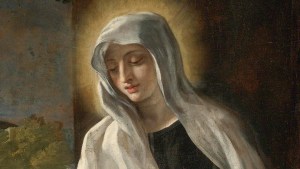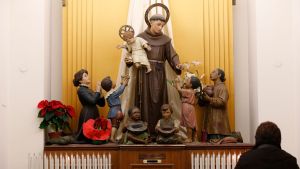Lenten Campaign 2025
This content is free of charge, as are all our articles.
Support us with a donation that is tax-deductible and enable us to continue to reach millions of readers.
Throughout Catholic history, saints have been appointed as patrons over all kinds of causes, people, and professions. While some patronages seem straightforward — like St. Francis of Assisi as the patron of animals — others might leave us scratching our heads. Yet, upon closer look, even the strangest patronages have a logic, often reflecting a moment from the saint’s life, their challenges, or the unique needs of the communities that honor them.
Here’s a look at five of the quirkiest saint patronages and the stories that make them surprisingly fitting.
1
ST. DROGO
Patron of Coffee House Owners and Unattractive People
St. Drogo, a 12th-century French shepherd turned monk, became known for his life of intense solitude and penance. Due to a mysterious ailment, he developed physical deformities and withdrew to live in isolation. Eventually, he was granted a small cell adjoining the local church, where he lived a solitary life of prayer and reflection. His solitary lifestyle and physical appearance earned him patronage over “unattractive” people, while his life of isolation resonates with those who spend long, quiet hours in cafes —making him an unusual yet relatable patron of coffee house owners.
2
St. Isidore of Seville
Patron of the Internet

A 7th-century scholar, St. Isidore dedicated his life to gathering and recording knowledge. His most famous work, Etymologiae, was an ambitious encyclopedia that aimed to summarize all known knowledge. Isidore’s passion for cataloging information has popularly, if unofficially, earned him the title of “patron saint of the internet.” The parallel between his work and the internet’s mission of information accessibility might seem a leap, but Isidore’s desire to make knowledge available to all fits perfectly in the digital age.
3
St. Elmo
Patron of Abdominal Pain

St. Elmo, also known as St. Erasmus, was a 3rd-century bishop and one of the Fourteen Holy Helpers. During his martyrdom, he endured severe tortures, including being disemboweled. After his death, sailors reported seeing a mysterious blue glow on ships’ masts, calling it “St. Elmo’s fire.” This phenomenon further cemented his association with protecting sailors, while the nature of his martyrdom has made him a patron for those suffering abdominal pain. His story reminds us of the compassion found in turning personal suffering into a source of aid for others.
4
St. Lawrence
Patron of Chefs and Comedians

St. Lawrence, a deacon in 3rd-century Rome, was famously martyred by being roasted on a gridiron. During his torture, he reportedly told his captors, “Turn me over; I’m done on this side!” His humor under unimaginable pressure endeared him to future generations, who honored him as the patron saint of chefs (for his unfortunate cooking experience) and comedians alike. His story reminds us of the power of laughter, even in the darkest times.
5
St. Polycarp
Patron of Earaches
St. Polycarp, an early Church bishop, was martyred in 155. While no tales connect him directly with earaches, his name “Polycarp” sounds phonetically similar to polio kairos (Greek for “many fruits”), a phrase misinterpreted in folk traditions. The connection stuck, and he became a saintly intercessor for ear-related pains (as if referring to one “mishearing” his name), showing how cultural and linguistic quirks can influence tradition.
These saints and their unusual patronages reflect a blend of human need, cultural memory, and compassion — qualities that make them both peculiar and relatable.






